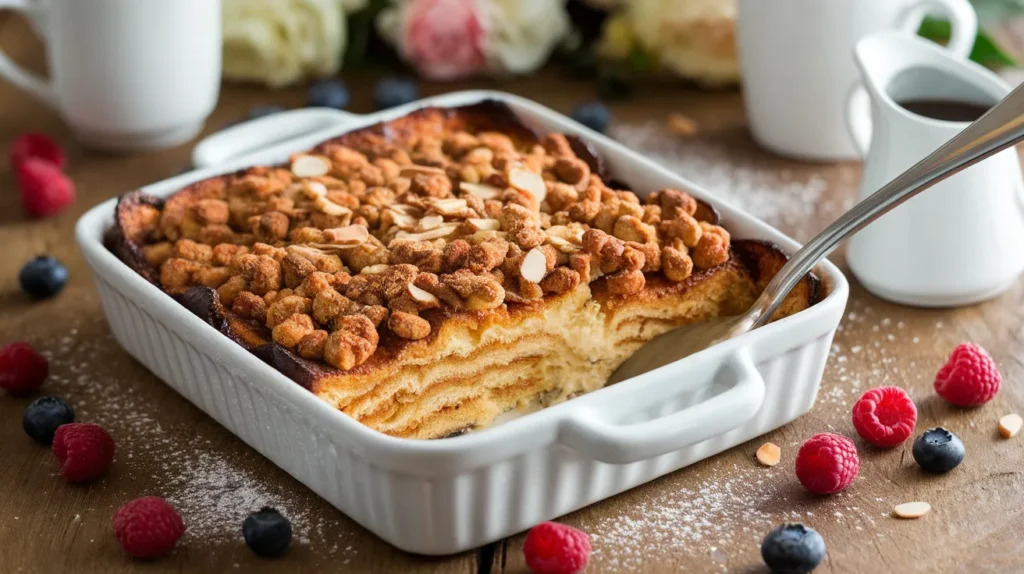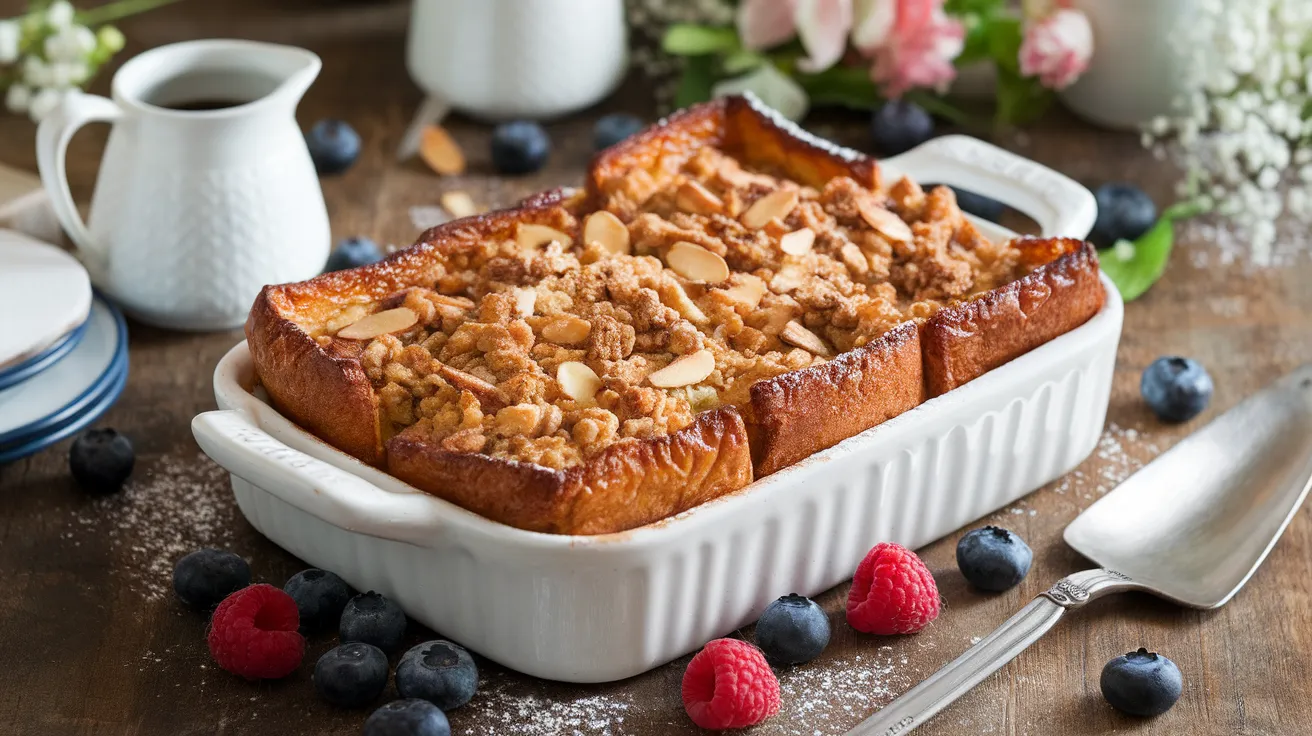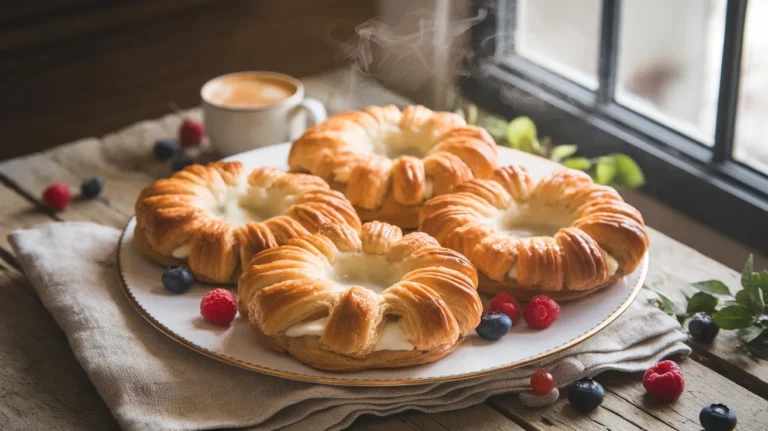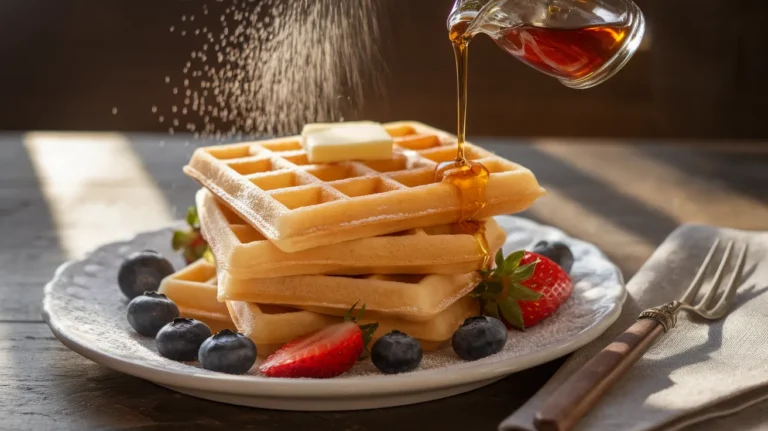This ricotta french toast casserole transforms ordinary breakfast into something extraordinary. Rich, custardy, and impossibly creamy, this make-ahead dish combines fluffy bread with velvety ricotta cheese for the ultimate brunch centerpiece. Perfect for lazy weekends or holiday mornings when you want something special without the stress.
SERVES: 4 | PREP: 15 MIN | COOK: 45 MIN | TOTAL: 60 MIN (Plus overnight refrigeration)
Why This Recipe Works
My ricotta french toast casserole has become my secret weapon for stress-free entertaining. The ricotta cheese creates an incredibly creamy custard that soaks into every corner of the bread, while overnight refrigeration lets the flavors meld beautifully. Unlike traditional french toast that requires standing at the stove, this version bakes hands-free while you sip your coffee.
The magic happens when ricotta meets eggs and cream to form a custard that’s richer than regular french toast but lighter than bread pudding. Each bite delivers that perfect balance of crispy edges and custardy center.
Ingredients
For the Casserole Base
| Ingredient | Measurement |
|---|---|
| Day-old challah or brioche bread | 8 cups, cubed (1-inch pieces) |
| Whole milk ricotta cheese | 1 cup |
| Large eggs | 6 |
| Whole milk | 1½ cups |
| Heavy cream | ½ cup |
| Granulated sugar | ⅓ cup |
| Pure vanilla extract | 2 teaspoons |
| Ground cinnamon | 1 teaspoon |
| Freshly grated nutmeg | ¼ teaspoon |
| Fine sea salt | ¼ teaspoon |
| Unsalted butter (for greasing) | 2 tablespoons |
For the Streusel Topping
| Ingredient | Measurement |
|---|---|
| All-purpose flour | ⅓ cup |
| Light brown sugar | ⅓ cup |
| Cold unsalted butter, cubed | 3 tablespoons |
| Ground cinnamon | ½ teaspoon |
| Sliced almonds (optional) | ¼ cup |
For Serving
| Ingredient | Measurement |
|---|---|
| Pure maple syrup | ¾ cup |
| Fresh berries | 2 cups |
| Powdered sugar for dusting | 2 tablespoons |
Step-by-Step Instructions
Phase 1: Preparing the Bread (5 minutes)
Step 1: Cut your challah or brioche into 1-inch cubes. Day-old bread works best because it absorbs the custard without turning mushy. If your bread is fresh, spread cubes on a baking sheet and let them sit out for 2-3 hours, or toast lightly at 300°F for 10 minutes.
Step 2: Generously butter a 9×13-inch baking dish, making sure to coat the corners and sides. This prevents sticking and creates delicious crispy edges. Set aside while you prepare the custard mixture.
Phase 2: Creating the Ricotta Custard (5 minutes)
Step 3: In a large mixing bowl, whisk together the ricotta cheese and eggs until completely smooth with no lumps remaining. This takes about 2 minutes of vigorous whisking. The ricotta should be fully incorporated into the eggs, creating a pale yellow mixture.
Step 4: Add the whole milk, heavy cream, granulated sugar, vanilla extract, cinnamon, nutmeg, and salt. Whisk for another minute until the sugar dissolves and you can’t feel any grains when you dip your finger in the mixture.
Step 5: Taste the custard mixture (it’s safe since we’re cooking it). It should be noticeably sweet because the bread will absorb and dilute some sweetness. If needed, add 1-2 more tablespoons of sugar.
Phase 3: Assembly (5 minutes)
Step 6: Place the bread cubes in your prepared baking dish, distributing them evenly without packing them down. You want air pockets for the custard to flow through.
Step 7: Pour the ricotta custard mixture over the bread cubes, using a spatula to spread it evenly. Gently press down on the bread with the back of a spoon to help it absorb the liquid, but don’t squash it completely.
Step 8: Cover the dish tightly with plastic wrap, pressing it directly onto the surface of the casserole. This prevents a skin from forming. Refrigerate for at least 8 hours or overnight. The bread needs this time to fully absorb the custard.
Phase 4: Making the Streusel Topping (While Casserole Chills)
Step 9: In a small bowl, combine flour, brown sugar, and cinnamon. Add the cold butter cubes and use a fork or your fingers to work it into the dry ingredients until the mixture resembles coarse crumbs. Mix in the sliced almonds if using. Cover and refrigerate until needed.
Phase 5: Baking (45 minutes)
Step 10: Remove the casserole from the refrigerator 30 minutes before baking to take the chill off. This ensures even cooking. Preheat your oven to 350°F.
Step 11: Remove the plastic wrap and sprinkle the streusel topping evenly over the surface. The topping should cover most of the casserole but small gaps are fine.
Step 12: Place the baking dish on the middle oven rack. Bake uncovered for 40-45 minutes until the top is golden brown and the center barely jiggles when you shake the dish. A knife inserted in the center should come out with just moist crumbs, not liquid custard.
Step 13: If the top browns too quickly (before 35 minutes), tent loosely with aluminum foil for the remaining baking time. This protects the streusel while the center finishes cooking.
Phase 6: Finishing and Serving
Step 14: Let the ricotta french toast casserole rest for 10-15 minutes after baking. This allows the custard to set properly so your slices hold their shape instead of collapsing.
Step 15: Dust with powdered sugar just before serving. Cut into squares and serve warm with maple syrup and fresh berries. The casserole should be creamy inside with crispy, caramelized edges.
Chef’s Notes
The ricotta makes all the difference in creating an ultra-creamy texture that regular french toast casseroles lack. It adds richness without heaviness.
If you love ricotta-based breakfast recipes, you’ll also enjoy my ricotta flourless pancakes which share that same luxurious creaminess.
Always use whole milk ricotta rather than part-skim. The fat content is crucial for achieving that silky, restaurant-quality custard.
For an extra special touch, try adding the lemon zest technique from my ricotta lemon pancakes – just 1 tablespoon of zest transforms this dish.
Nutrition Information (Per Serving)
- Calories: 485
- Protein: 18g
- Carbohydrates: 52g
- Fat: 23g
- Fiber: 2g
- Sugar: 28g
Creative Variations
Berry Bliss Version: Fold 1½ cups of fresh blueberries or sliced strawberries into the bread cubes before adding the custard. The berries create pockets of jammy sweetness throughout.
Chocolate Chip Indulgence: Add ¾ cup of dark chocolate chips between the bread layers. Use a quality chocolate with at least 60% cacao for best results. The chips melt into gooey pools of chocolate heaven.
Savory Breakfast Twist: Omit the cinnamon, nutmeg, and sugar from the custard. Add ½ cup grated parmesan, 1 cup diced ham, and fresh herbs instead. Perfect for brunch with a side salad.
Tropical Paradise: Replace the cinnamon with cardamom and add ½ cup toasted coconut flakes and ⅓ cup diced pineapple. Top with coconut cream instead of maple syrup for serving.
Storage & Reheating Guide
Refrigerator Storage: Cover leftover ricotta french toast casserole tightly with aluminum foil or transfer to an airtight container. Keeps fresh for up to 4 days in the refrigerator.
Freezing Instructions: Cut cooled casserole into individual portions. Wrap each piece in plastic wrap, then aluminum foil. Freeze for up to 2 months. Thaw overnight in the refrigerator before reheating.
Reheating Method: For best results, reheat in a 325°F oven for 15-20 minutes until warmed through. Cover with foil to prevent over-browning. Microwave works in a pinch (1-2 minutes on 70% power), but the oven preserves that crispy top.
Make-Ahead Tip: Assemble the entire casserole up to 2 days ahead. Keep refrigerated and add the streusel topping just before baking. This is perfect for holiday mornings when you want minimal fuss.

Troubleshooting Common Issues
Problem: Soggy, Wet Center The bread wasn’t dry enough or the casserole needs more baking time. Use day-old bread and bake an extra 10-15 minutes. The center should barely jiggle, not slosh.
Problem: Dry, Tough Texture You over-baked it or didn’t use enough custard. Check for doneness at 40 minutes and tent with foil if the top looks done but the center isn’t set. Next time, ensure every bread cube is thoroughly soaked.
Problem: Ricotta Clumps in Custard The ricotta wasn’t whisked enough with the eggs. Always whisk the ricotta and eggs first until completely smooth before adding other liquids. A hand mixer works great for this.
Problem: Burnt Top, Raw Center Oven temperature is too high or the casserole is too close to the heating element. Move the rack to the middle position and reduce temperature to 325°F. Cover with foil halfway through baking.
Problem: Casserole Collapsed After Cutting It didn’t rest long enough or was under-baked. Always rest for 10-15 minutes after removing from the oven. The custard needs this time to set properly for clean slices.
Equipment Essentials
- 9×13-inch baking dish (ceramic or glass works best)
- Large mixing bowl for custard
- Whisk (balloon whisk preferred)
- Sharp serrated knife for cutting bread
- Measuring cups and spoons
- Rubber spatula for spreading
- Aluminum foil for covering
- Oven thermometer (optional but helpful)
Shopping List
Bakery Section
- Day-old challah or brioche bread (1 loaf)
Dairy Case
- Whole milk ricotta cheese
- Large eggs (half dozen)
- Whole milk
- Heavy cream
- Unsalted butter
Baking Aisle
- Granulated sugar
- Light brown sugar
- All-purpose flour
- Pure vanilla extract
- Ground cinnamon
- Ground nutmeg
- Sliced almonds (optional)
Pantry
- Fine sea salt
- Pure maple syrup
- Powdered sugar
Produce
- Fresh berries for serving
Success Secrets
1. The Overnight Soak Is Non-Negotiable Don’t skip the refrigeration time. Eight hours minimum allows the bread to fully absorb the custard without turning to mush. This makes the difference between mediocre and magnificent.
2. Quality Bread Matters Challah or brioche creates the best texture in this ricotta french toast casserole. Their egg-rich dough complements the custard perfectly. In a pinch, use thick-cut French bread, but avoid sandwich bread which gets too mushy.
3. Room Temperature Ingredients Mix Better Take the eggs and ricotta out of the fridge 30 minutes before starting. This prevents the ricotta from clumping when mixed with cold eggs and creates a smoother custard.
4. Test for Doneness Correctly The center should still have a slight jiggle when you gently shake the pan. It continues cooking as it rests. If it’s completely firm in the oven, it’ll be overcooked after resting.
5. Serve Immediately After Resting The casserole is at its absolute best 15-20 minutes after coming out of the oven. The texture is perfect – creamy but not runny, with those irresistible crispy edges still warm and crunchy.




